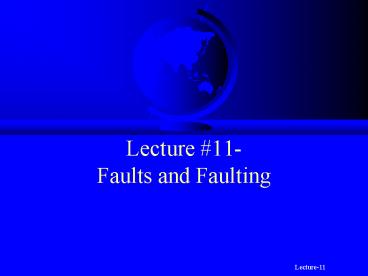Lecture PowerPoint PPT Presentation
1 / 45
Title: Lecture
1
Lecture 11- Faults and Faulting
2
Faults Bound the Major Plates
3
Rock Deformation
- Rocks slowly deform as a result of Earths
convection and thermal cooling. - Where the rocks are cool and brittle, they can
stick together along faults that fracture causing
earthquakes. - Deep below Earths surface, where it is hot, the
rocks bend and flow like taffy.
4
Rock Deformation
- The specific style of rock deformation depends on
- Composition
- Temperature
- Pressure
- Strain Rate
5
Rock Behavior
- In general, rocks will either flow or fracture
depending on their temperature. - However, even cold rocks can sustain some strain
before they break. - If the strain is released before the strength of
the rock is exceeded, the rock returns to its
original shape.
6
Rock Fractures (Faults Joints)
- A joint is a fracture across which the sides have
not moved. - A fault is a crack across which the two sides
have moved.
7
Joints
8
Joints and Weathering
9
Fault Scarps
- An exposed fault surface is called a scarp.
10
Faults (Fairview Valley, NV)
11
San Andreas (central CA)
12
Fault Structure
- We dont have many examples of what faults look
like far below Earths surface, but heres an
example.
13
CaliforniaFaults Large Ruptures
14
Earthquakes and Faults
- Earthquakes occur on faults, but not all of the
fault ruptures during each earthquake. - The hypocenter (or focus) is the place where the
rupture begins, the epicenter is the place
directly above the hypocenter.
15
Hypocenter and Epicenter
16
Rupture Size
- Larger earthquakes rupture larger faults or
larger fractions of faults.
17
Fault Geometry Terminology
- We need some definitions and concepts that we can
use to discuss faults. - Important Terms
- Hanging Wall / Foot Wall
- Strike
- Dip
- Slip
18
Dip ( Hanging Wall/Foot Wall)
- The orientation of the fault surface with respect
to Earths surface is defined by the fault dip.
19
Strike
- Strike is an angle use to describe the
orientation of the fault surface with respect to
North.
20
Slip
- Slip is the angle used to describe the
orientation of the movement of the hanging wall
relative to the foot wall.
21
Faulting Styles
- There are four basic styles of faulting
- Normal
- Reverse
- Strike-Slip
- Oblique
- The type of faulting depends on the slip
direction (the movement of the hanging wall with
respect to the foot wall).
22
Slip Direction
- If the slip is in the direction of the dip, we
call it a dip-slip motion. - If the slip is in the direction of strike, we
call it a strike-slip (or transform) motion.
23
Normal Faulting
- The hanging wall slides down the fault - as you
would expect (thats why its called normal).
24
Faults (Fairview Valley, NV)
25
Reverse Faulting
- The hanging wall is pushed up the fault - not
what you would expect (thats why its called
reverse).
26
Strike-Slip Faulting
- The hanging wall horizontally (no motion in the
direction of fault dip). - There are 2 cases depending on how the rocks on
the other side of the fault move - right lateral
and left lateral.
27
SF 06 - Left or Right Lateral?
28
Oblique Faulting
- A combination of dip-slip and strike-slip motion.
29
Faulting Summary
30
Stress
- Stress is a force per unit area.
- Examples
- Pressure
- Friction
- Stress is an important parameter in faulting. A
fault fails when the stress on the fault
becomes larger than the frictional forces holding
the fault together.
31
Faulting and Stresses
- The style of faulting (normal, reverse, etc.)
also tells us about the stresses acting within
Earth. - We describe the stresses by considering three
stresses, two horizontal and the vertical.
32
Normal Faulting Stresses
33
Reverse Faulting Stresses
34
Strike-Slip Faulting Stresses
35
Stress Faulting Summary
- At any place there are three principal stresses
acting on a fault. - If the vertical stress
- Largest - Normal Faulting
- Smallest - Reverse Faulting
- Intermediate - Strike-Slip Faulting
36
Faulting and Seismograms
- The nature of faulting affects the amplitudes and
shapes of seismic waves (this allows us to use
seismograms to study the faulting). - We call the variation in wave amplitude with
direction the radiation pattern.
37
Radiation Patterns
- Radiation patterns are common in the study of
sources of just about anything.
38
Faulting Shear Waves
- Faulting generates large shear waves because
earthquakes release shear strains stored in the
rocks around the fault.
39
Radiation Patterns in 3D
40
Seismic Beach Balls
- We use the radiation patterns of P-waves to
construct a graphical representation of
earthquake faulting geometry. - The symbols are called Focal Mechanisms or
Beach Balls, and they contain information on
the fault orientation and the direction of slip.
41
Representing a Plane
42
The Principal Mechanisms
43
Faults and Plates
- The style of faulting tells us something about
the forces acting in a particular part of Earth. - Along plate boundaries, faulting reflects the
motion of plates. - Divergent Boundary Normal Faulting
- Convergent Boundary Reverse Faulting
- Transform Boundary Strike-Slip Faulting
44
Example East Africa
45
Summary
- Faults are rock fractures across which the rocks
have moved. - Earthquakes occur along faults.
- Faulting geometry (strike, dip, slip) is related
to the stresses acting on the rocks. - The three faulting styles (normal, strike-slip,
and reverse) reflect the deformation occurring
within Earth and vary systematically with plate
boundary style

